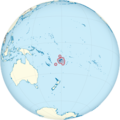Difference between revisions of "Fiji Energy Situation"
***** (***** | *****) m (→Introduction) |
***** (***** | *****) m |
||
| Line 1: | Line 1: | ||
| + | |||
{{CES Country | {{CES Country | ||
|CES Country Name=Fiji | |CES Country Name=Fiji | ||
| Line 6: | Line 7: | ||
}} | }} | ||
| + | <br/> | ||
| + | <br/> | ||
| − | + | <br/> | |
| − | |||
= Introduction = | = Introduction = | ||
| Line 15: | Line 17: | ||
Fiji is an island country with over 300 small islands and almost 900,000 people (2016). Due to its geography, affordable and accessible energy supply is a challenge. Fiji is a small island developing state (SIDS) and depends heavily on imported fossil fuel to meet its energy needs. Electricity is mainly produced by diesel and hydro power. <span><span><span><span>Fuel oil imports in 2016 were estimated to total US$346 million (F$737 million), accounting for 16% of Fiji’s total national import bill. <span><span></span></span></span></span></span></span>The transport sector is <span><span>the main consumer of refined fuel oils, mostly gasoline, oil (diesel), and aviation turbine fuel. <span><span><span><span>Power generation from renewable energy sources, mainly hydro, accounted for 54 percent of energy production.</span></span><ref name="https://www.export.gov/article?id=Fiji-Energy">https://www.export.gov/article?id=Fiji-Energy</ref> </span></span></span></span> | Fiji is an island country with over 300 small islands and almost 900,000 people (2016). Due to its geography, affordable and accessible energy supply is a challenge. Fiji is a small island developing state (SIDS) and depends heavily on imported fossil fuel to meet its energy needs. Electricity is mainly produced by diesel and hydro power. <span><span><span><span>Fuel oil imports in 2016 were estimated to total US$346 million (F$737 million), accounting for 16% of Fiji’s total national import bill. <span><span></span></span></span></span></span></span>The transport sector is <span><span>the main consumer of refined fuel oils, mostly gasoline, oil (diesel), and aviation turbine fuel. <span><span><span><span>Power generation from renewable energy sources, mainly hydro, accounted for 54 percent of energy production.</span></span><ref name="https://www.export.gov/article?id=Fiji-Energy">https://www.export.gov/article?id=Fiji-Energy</ref> </span></span></span></span> | ||
| + | <br/> | ||
= Energy Situation = | = Energy Situation = | ||
| − | |||
= Renewable Energy = | = Renewable Energy = | ||
| − | |||
= Fossil Fuel = | = Fossil Fuel = | ||
| − | |||
= Key Problems of the Energy Sector = | = Key Problems of the Energy Sector = | ||
| − | |||
= Policy Framework, Laws and Regulations = | = Policy Framework, Laws and Regulations = | ||
| − | |||
= Institutional Set up in the Energy Sector = | = Institutional Set up in the Energy Sector = | ||
| − | |||
= Further Information = | = Further Information = | ||
| + | = References = | ||
| − | + | <references /> | |
| + | [[Category:Fiji]] | ||
[[Category:East_Asia_and_Pacific]] | [[Category:East_Asia_and_Pacific]] | ||
| − | |||
Revision as of 12:58, 6 November 2017
Capital:
Suva
Region:
Coordinates:
17.8000° S, 178.0000° E
Total Area (km²): It includes a country's total area, including areas under inland bodies of water and some coastal waterways.
18,270
Population: It is based on the de facto definition of population, which counts all residents regardless of legal status or citizenship--except for refugees not permanently settled in the country of asylum, who are generally considered part of the population of their country of origin.
929,766 (2022)
Rural Population (% of total population): It refers to people living in rural areas as defined by national statistical offices. It is calculated as the difference between total population and urban population.
42 (2022)
GDP (current US$): It is the sum of gross value added by all resident producers in the economy plus any product taxes and minus any subsidies not included in the value of the products. It is calculated without making deductions for depreciation of fabricated assets or for depletion and degradation of natural resources.
4,979,979,546 (2022)
GDP Per Capita (current US$): It is gross domestic product divided by midyear population
5,356.16 (2022)
Access to Electricity (% of population): It is the percentage of population with access to electricity.
92.10 (2021)
Energy Imports Net (% of energy use): It is estimated as energy use less production, both measured in oil equivalents. A negative value indicates that the country is a net exporter. Energy use refers to use of primary energy before transformation to other end-use fuels, which is equal to indigenous production plus imports and stock changes, minus exports and fuels supplied to ships and aircraft engaged in international transport.
no data
Fossil Fuel Energy Consumption (% of total): It comprises coal, oil, petroleum, and natural gas products.
0.00 (2007)
Introduction
Fiji is an island country with over 300 small islands and almost 900,000 people (2016). Due to its geography, affordable and accessible energy supply is a challenge. Fiji is a small island developing state (SIDS) and depends heavily on imported fossil fuel to meet its energy needs. Electricity is mainly produced by diesel and hydro power. Fuel oil imports in 2016 were estimated to total US$346 million (F$737 million), accounting for 16% of Fiji’s total national import bill. The transport sector is the main consumer of refined fuel oils, mostly gasoline, oil (diesel), and aviation turbine fuel. Power generation from renewable energy sources, mainly hydro, accounted for 54 percent of energy production.[1]





















